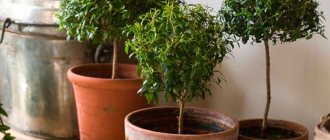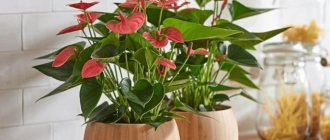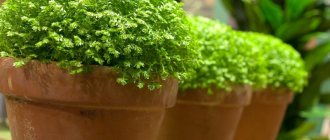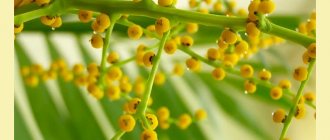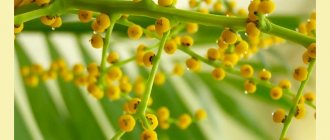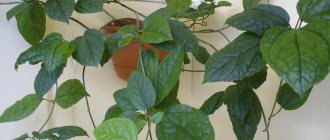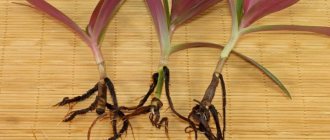Author: Elena N. https://floristics.info/ru/index.php?option=com_contact&view=contact&id=19 Category: Houseplants Published: February 27, 2017Last edits: April 15, 2021
- Care during flowering
- Growing from seeds
- Diseases and their treatment
- Nepenthes alata
flower (lat. Nepenthes), or pitcher plant, is the only genus of the monotypic family Nepentheaceae. The name “nepenthes” comes from the word “nepenthes” - this is what the herb of oblivion was called in ancient Greek mythology. Where does Nepenthes grow? Most of the representatives of this genus grow in the tropics of Asia, in particular on the island of Kalimantan. The distribution border of Nepenthes in the west reaches Madagascar and the Seychelles, and in the east – New Caledonia, New Guinea and Northern Australia. The predatory plant Nepenthes, which feeds on insects, has strong symbiotic relationships with some representatives of the animal world. For example, large species of the plant are used by mountain tupai as dry toilets: the animals feast on Nepenthes nectar and leave their droppings in the jugs, which serve as fertilizer for the plant. And bats climb into traps to sleep - here they are not bothered by insects and do not have to compete for a sleeping place. As a thank you, the mice leave the plant their excrement, which contains the nitrogen it needs.
Planting and caring for nepenthes
- Flowering: 3 to 7 months in spring and summer.
- Lighting: bright diffused light (southern or eastern window sills with shading during the midday hours). When grown on a northern windowsill in winter, the plant will require additional artificial lighting for 16 hours.
- Temperature: mountain species feel good in the warm season at a temperature of 18-20 ˚C, and in winter at 12-15 ˚C. Lowland Nepenthes prefer temperatures from 22 to 26 ˚C during the period of active growth, and in winter – 16-20 ˚C.
- Watering: regular, preferably through drainage holes. In the warm season, the substrate in the pot should be slightly damp all the time, and in winter it should be allowed to dry to a depth of 5 mm.
- Air humidity: some species require very high humidity - 70-90%; for others, a humidity level of 40% during the day and at least 50% at night is sufficient. Keep Nepenthes on a tray of wet peat or expanded clay and spray its leaves with water daily.
- Fertilizing: Nepenthes is an insectivorous plant and does not require fertilizers. Once a month, place a live bloodworm, fly or spider in one jug, and a different one each time.
- Dormant period: not clearly expressed, but due to operating heating devices, the jugs begin to dry out. In the spring, simply cut the leaves almost to the base, restore the watering regime and water the substrate with a very weak solution of complex mineral fertilizer.
- Replanting: in spring, if absolutely necessary.
- Reproduction: by cuttings, dividing the bush and by seed.
- Pests: aphids and mealybugs.
- Diseases: fungal rot.
Read more about growing Nepenthes below.
Brief description of cultivation
- Bloom . It is observed in the spring-summer period and lasts 3–7 months.
- Illumination . The light should be bright, but diffused. A window facing south or east is best, but the bush must be protected from the scorching midday rays of the sun. If it stands on a north window, then in winter it will need backlighting for 16 hours.
- Temperature regime . Mountain species grow and develop well at air temperatures from 18 to 20 degrees in summer and spring, and at 12–15 degrees in winter. Plain species should be kept cool in winter (from 16 to 20 degrees), and during the spring-summer period at a temperature of 22-26 degrees.
- Watering . The soil mixture in the pot is moistened systematically, and bottom watering (through drainage holes) is best suited for this plant. In spring and summer, make sure that the soil mixture in the pot is always slightly moist. In the cold season, watering is carried out only when the soil mixture dries to a depth of about 0.5 cm.
- Humidity . Some Nepenthes species require high air humidity: within 70–90 percent. At the same time, other species feel quite comfortable at a humidity of about 40% during the day, and at least 50% at night. Every day, moisten the foliage with a spray bottle, and also pour wet expanded clay or peat into the tray.
- Fertilizer . This carnivorous plant does not need feeding, as it receives nutrients from the insects it eats. Once every 4 weeks you need to put a live insect (fly, spider or bloodworm) into the jug. In this case, you need to put the insect in a different jug each time.
- Rest period . Not clearly expressed. However, during the heating season, the jugs dry out. With the onset of spring, it is necessary to cut off all the foliage almost to the ground, after which it will be necessary to restore the watering regime, as well as fertilize with a solution of a weakly concentrated mineral complex.
- Transplant . It is carried out in the spring and only when necessary.
- Reproduction . By dividing the bush, cuttings and seeds.
- Pests . Mealybugs and aphids.
- Diseases . Fungal rot.
Botanical description
The insectivorous plant Nepenthes is most often a subshrub or shrubby mixotrophic vine. Nepenthes, with long herbaceous stems, climb branches and tree trunks to many meters in height in search of sunlight for their narrow terminal paniculate or racemose inflorescences. The leaves of Nepenthes are large, alternate, with a convex midrib and an elongated apex.
Venus flytrap - home care
In addition to ordinary leaves, the plant also develops pitcher leaves, the lower part of the petiole of which, connecting to the stem, is flat and wide, and then it transforms into a thin tendril wrapping around a branch, at the end of which hangs a pitcher, similar to an outlandish flower. The size, shape and color of the jug depend on the type of Nepenthes. The length of the trap can be from 2.5 to 30 cm, although there are species with jugs of half a meter. The color of the pitchers is usually bright - matte white, spotted, red or light green with purple dots. The upper edge of the jug is curved inward and covered with purple or pink grooves.
Special cells located on the inner edge of the jug produce sweet nectar, the inside of the jug is filled with water or digestive fluid containing the nepenthesin enzyme, and the neck is covered with a lid that protects the trap from debris getting into it. Insects, attracted by the aroma of nectar, crawl under the cap, slide into the digestive fluid and drown in it. Digestion of food lasts from 5 to 8 hours, as a result of which only the chitinous shell remains of the insects. Sometimes even birds, amphibians and rodents get into the jugs.
- Abutilon - care, photos, types
Nepenthes flowers are inconspicuous, dioecious, petalless, with imbricated sepals. The fruit is a leathery capsule, divided by partitions into chambers, in each of which small seeds ripen.
In indoor culture, Nepenthes is still rare, since almost all representatives of the genus are too large for small greenhouses, and it is difficult to keep predatory Nepenthes on a windowsill - it requires high air humidity. It is best to grow nepenthes in greenhouses, and their smaller species in a “closed tropical window.”
General description with photo
Nepenthes from the Nepentheaceae family is a representative of mixotrophs - plants with a special type of nutrition, capable of obtaining what they need for life from different sources, depending on the circumstances. This method of nutrition has been formed over many centuries and is due to the harsh conditions of natural growth. The inflorescence of Nepenthes is a closing vessel, which also increases in size as it grows and develops. Nectar is produced inside the flower, the aroma of which attracts insects. However, once they are trapped, they cannot get back out. Dead insects or rodents dissolve under the influence of this nectar, and the plant takes from these remains everything it needs for its development.
However, calling pitcher traps flowers is not entirely correct; in fact, they are modified leaves. They can look very different in shape, color and size, depending on the variety.
Caring for Nepenthes at home
Growing conditions
Nepenthes needs bright but diffused light, so it is best to keep the plant on a southern or eastern windowsill, protected from the scorching midday rays with a translucent cloth or paper. When growing a pitcher plant on a western or northern window, provide additional lighting for it. In winter, artificial lighting should work for 16 hours.
According to the requirements for temperature conditions, Nepenthes species can be divided into two groups:
- mountainous - these plants develop comfortably in spring and summer at a temperature of 18-20 ºC, and in winter at 12-15 ºC. Too high a temperature for a long time can provoke the development of diseases;
- lowland nepenthes prefer temperatures from 22 to 26 ºC in summer, but in winter it should be between 16-20 ºC. At lower temperatures, plant life may be at risk.
Ventilate the room regularly so that the air in it does not stagnate, but protect nepenthes from drafts and try to move it as little as possible, because the plant does not like moving and turning around its axis. If you disturb it, Nepenthes may freeze for a month or a month and a half and stop forming pitchers.
Since Nepenthes is a vine, you should prepare a support for it, to which it will need to be tied as soon as it reaches a height of half a meter. It is best to install a support when transplanting a one-year-old plant.
Watering
Caring for Nepenthes includes such a mandatory item as regular moistening of the substrate. To water the plants, use distilled or at least filtered, settled or rainwater at room temperature, or preferably a couple of degrees warmer. The method of watering Nepenthes is from the bottom, after which you must allow excess water to drain. In spring and summer, the substrate in the pot should be slightly moist all the time; in winter, Nepenthes is watered a couple of days after the top 5 mm thick layer of the substrate has dried. If the plant overwinters in a cool place, watering should be careful and not very abundant.
The moisture-loving predator Nepenthes needs not only moist soil - many species also need high air humidity in the range of 70-90%. However, among the pitcher plants grown indoors, there are many that require a humidity level of 40% during the day and 50% at night. Observe the condition of the plant under your usual conditions - it is quite possible that it will be able to adapt to the humidity of the air in your home, but if this does not happen, spray it daily with settled water and place the pot with nepenthes on a tray with damp peat or expanded clay.
Transfer
Nepenthes is replanted only if necessary, which arises, for example, when mold appears on the substrate or the pot no longer corresponds to the size of the root system. Pots, hanging baskets for orchids or flowerpots are used as dishes, and the diameter of the dishes must be at least 14 cm. Store-bought soil for orchids can serve as a substrate.
If you prefer to prepare the soil for nepenthes yourself, mix three parts leaf soil, two parts peat, one part sand and add a little charcoal to this mixture. Or add two parts of high-moor peat to two parts perlite and one part vermiculite. Keep in mind that the pitcher plant does not like acidic soils.
Transplantation is carried out in the spring. If the plant is absolutely healthy, it is transferred from the old container to a new one, trying not to damage the roots. But if you are concerned about the appearance of Nepenthes, remove the plant from the old pot, clean the root system from the substrate and rinse it with distillate, then finish the replanting in the usual way, water the substrate and spray the pitcher plant on the leaves with a solution of Fundazol or Topaz so that the composition gets into the substrate .
If the rooting of Nepenthes is successful, after a couple of weeks, spray the flower and spill its substrate with Zircon solution at the rate of 2-3 drops of the drug per 200 ml of distilled water. After a correctly performed transplant, Nepenthes will live in a new pot for 3-5 years, and if you use volcanic stone, mineral wool, coconut shells or any other slowly decomposing materials as a substrate, then the next time the plant will need to be replanted only after 10 years.
Fertilizer
There is no need to fertilize the Nepenthes soil, since the carnivorous flower obtains its food by eating insects. But there will be no harm if in the summer, once a month, you add complex flower fertilizer to the substrate in a consistency three times weaker than recommended for indoor plants: if you overfeed Nepenthes with fertilizers, it will not form jugs.
- Photo of decorative deciduous Fittonia
Nepenthes at home is fed once a month, throwing a bloodworm, spider or fly into a jug - one insect per jug, and not all of it, but only half of it, otherwise the plant will die from excess nitrogen. The insect must be alive. The digestive secretion is formed in the jugs only once, and if the jug is suddenly empty, it will no longer work as a stomach, so do not throw insects into it - this will only lead to the death of the leaf. To extend the life of an empty jug, fill it one-third full with distilled water.
Nepenthes - what kind of predatory flower is it?
Nepenthes is a member of the Nepentaceae family. It is a predator plant. These are shrubby, sometimes semi-shrubby vines. The plant has two types of leaves: large and pitcher-shaped, which is why it is called “pitcher”. With the help of jugs, it obtains food for itself - insects.
Nepenthes - an unusual plant
The plant looks unusual - it has bright large leaves reaching 30 cm in height. In addition to them, there are “digestive organs” - the tip of the leaf is transformed into a small tendril. With the help of antennae, a pitcher is attached to the leaf, through which the plant hunts insects.
Nepenthes flowering
Care during flowering
Nepenthes flowers, regular, reddish-brown, collected in erect inflorescences, bloom for quite a long time, sometimes more than six months. You can’t call them spectacular, but their unusualness still attracts.
Nepenthes in winter
Nepenthes does not need rest, but due to the fact that our winters are not like tropical ones, maintaining the plant has its own subtleties. With the onset of deep autumn, all feeding of the plants stops, and the intervals between waterings become longer. Don't worry about the jugs starting to dry out - this is because the indoor air is too dry in winter. In the spring, before the start of a new growing season, cut off all the leaves almost to the base, resume normal watering, add a fertilizer solution to the substrate, and Nepenthes will begin to grow again.
Taxonomy
Nepenthes alata
has long been considered a highly polymorphic species, covering all the main islands of the Philippine archipelago (with the possible exception of Palawan).[19]
Under this broad limitation, N. alata
was considered to have an altitude range of 0–1,900 m (0–6,234 ft) above sea level [17] and has been recorded from the islands of Bohol, Camiguin, Cebu, Culion, Leyte, Luzon, among others , Mindanao, Mindoro, Negros, Panay, Samar,[20][21] and Sibuyan.
Nepenthes alata
in this broad sense (
Sensu lato
) is one of the easiest and most popular
Nepenthes
to grow.[22]
In 2013, N. alata
was redefined by Martin Cheek and Matthew Jebb to cover only the population of northern and central Luzon with apparently hairy pitchers (a taxon known in horticultural circles as "hairy
N. alata
").[7]
Chick and Jebb N. alata sensu stricto
has a height of 550 m (1,800 ft) and higher.[7]
According to this interpretation, more southern plants previously assigned to this species actually represent recently resurrected N. graciliflora
(the "typical
N. alata
" of horticulture; found in Bohol, Leyte, Luzon, Mindanao, Mindoro, Panay, Samar, and Sibuyan ), as well as the recently described
N. negros
(Biliran and Negros) and
N. ramos
(Mindanao).[7][23]
Nepenthes viridis
from Dinagat and Samar is another close relative,[24] as are
N. ceciliae
(Mindanao),
N. copelandii
(Mindanao),
N. extincta
(Mindanao),
N. hamiguitanensis
(Mindanao),
N. kitanglad
( Mindanao),
N. curata
(Mindanao),
N. leite
(Leyte),
N. mindanaoensis
(Dinagat and Mindanao),
N. saranganiensis
(Mindanao) and
N. ultra
(Luzon).[7][17][23][ 25][26][27]
Together these species form the so-called " N. alata
group", united by a number of morphological characters, including winged petioles, caps with basal ridges on the lower surface (often developed into appendages) and apical pitchers that are usually widest at the base.[25] ]
Nepenthes alata
is closely related to several other species, including
N. copelandii
,
N. mindanaoensis
, and
N. saranganiensis
.
Nepenthes eustachia
from Sumatra was once considered to fall within the variation of
N. alata
, but this was based on misinterpretation of the type specimens;
the two species do not appear to be closely related to each other.[ citation needed
]
Morphological differences between N. alata
and
N. eustachia
(Jebb and Cheek, 1997)
| Morphological character | N. alata | N. eustachia |
| Leaf blade | lanceolate-ovate | lanceolate |
| Leaf tip | acute or weakened | round to semi-peltate |
| petiole | broad-winged | little-winged or wingless |
| Spur | simple, acute | simple or bifurcated |
| Indumentum | reddish or whitish hair | missing everywhere |
| Structure of the base of the jug | texture similar to the rest of the jug, sharply softened to a tendril | angular, woody, gradually turning into a tendril |
Reproduction of Nepenthes
Growing from seeds
Generative propagation of Nepenthes is an interesting and not very complicated process, if you do not take into account the fact that you are unlikely to be able to buy seed material: no matter what the sellers promise you, instead of Nepenthes seeds you will most likely receive the seeds of some other plant. Another problem with generative propagation is that pitcher plant seeds remain viable for no longer than 2-3 weeks. But if you manage to get your hands on fresh seed, you will almost certainly be able to grow Nepenthes from seeds.
The seeds are evenly distributed over the surface of moistened sphagnum moisturized and disinfected for 2-3 minutes in the microwave, then placed in a plastic container with drainage holes. The crops are moistened with a fine spray, immersed in a plastic box, covered with a transparent lid to create maximum air humidity around the crops, and placed in a greenhouse under a phytolamp.
You will have to ventilate the crops daily and measure the humidity and air temperature in the greenhouse, which should be maintained at 20 ºC and 90-100%, respectively. As soon as the sprouts appear, care for them as you would for any tropical plant, but try to spread their adaptation to the conditions of your home over several weeks.
Cuttings
It is much easier to propagate nepenthes by vegetative methods, for example, by cuttings, especially since in early spring after pruning the pitcher plant you will have many cuttings for rooting. The ideal cutting is a piece with three leaves, which are shortened by 2/3. If the cutting is apical, the small top leaf does not need to be cut off. Before planting, the cuttings are placed in Kornevin’s solution for 30 minutes, after which the sections are sprinkled with crushed coal.
The container for planting cuttings must be washed well with bleach, and then be sure to rinse with distillate. The substrate for cuttings is made up of coconut fiber, sphagnum and peat in a ratio of 3:2:5 with the addition of a small amount of vermiculite, after which the soil must be processed in the microwave for 15 minutes. Do not forget to moisten the substrate with distilled water before doing this.
The lower cut of the cuttings is immersed in the soil by at least 5 mm, the substrate is carefully pressed around the cuttings, watered with distillate, and the cuttings are sprayed with a solution of Fundazol, after which the container is placed in a greenhouse - under a large plastic bag or a transparent plastic cap. Keep the greenhouse in a bright place at a temperature of 23 ºC. After two weeks, you need to spray the cuttings and spill the substrate with Zircon solution - 2-3 drops of the drug are dissolved in 200 ml of distilled water.
Rooting usually lasts a month or a month and a half, but after two weeks it will become clear whether the cuttings have taken root: if they darken, then rooting has not taken place, but if the planted sections produce new shoots with jugs, we can assume that the process was successful. And in a year it will be possible to transfer the new plants into personal pots.
Dividing the bush
Nepenthes also reproduces by dividing the bush when transplanting, but its roots are so fragile that they can easily be damaged. If you have experience in such matters, then take the risk of carrying out this type of reproduction. The procedure for dividing a nepenthes bush is no different from the process of dividing other plants.
How does Nepenthes reproduce?
The plant is propagated in several ways.
Propagation by seeds
Cambria orchid: care and maintenance at home
Domestic specimens are not so often propagated by seeds, because it is problematic to fulfill all the necessary conditions. To propagate a plant using this method, you need fresh seeds, which are difficult to get even in a special store.
Additional Information! It is difficult to find fresh seeds in specialized stores. Even if they offer to purchase these, it is impossible to verify their freshness. Sellers often sell old seeds under the guise of fresh ones.
It is possible to obtain seeds yourself. To do this, take male and female plants. They are fertilized with flies and midges to produce fruit. Since domestic specimens rarely bloom, propagation by this method is not the fastest option.
Fresh seeds are planted in small containers. They grow in high humidity up to 100% and in a well-lit place. If everything is done correctly, the first results are visible after a few months.
Apical cuttings
Cuttings are cut in the spring, using the upper part. First, the cuttings are placed in a special solution for half an hour. Planting is done in damp sphagnum moss. This is a long process and requires special care. The cuttings are protected from direct light. After two weeks, spray with Zircon. If the cutting loses color, the process was unsuccessful, and if it did not lose color, the process was successful.
Note! Roots appear within a few months. After another couple of months, the cuttings are transplanted, and the next transplant occurs no less than a year later.
Propagation of Nepenthes by cuttings
Air layering
Remove a piece of shoot bark and press part of the vine to the substrate. After a few months, roots will appear. The cuttings are placed in an individual pot.
Root layering
This method is used when transplanting an adult flower. Move the nepenthes plant into a container of water and clean the roots. Using tools, a part of the plant with roots is separated and nepenthes is planted according to the description.
Diseases and pests
Diseases and their treatment
Sometimes the leaves of Nepenthes become covered with brown or red spots, which is a sign of a fungal disease that develops against the background of increased soil and air humidity. To treat plants from infection, fungicidal preparations are used. If the stem of your nepenthes turns black and the leaves wrinkle and droop, it means you are watering it too often and its roots are rotting.
Why do Nepenthes leaves rot? For the same reason - due to excess moisture. Try to save the flower by removing it from the substrate, carefully cutting off the rotten organs and areas with a sterile instrument, treating the sections with crushed coal and transplanting the plant into a new sterile substrate. If you couldn’t save the Nepenthes, root as many cuttings as possible, and it is quite possible that after a while you will have new Nepenthes.
Leaves that turn yellow at the wrong time indicate that the plant lacks nutrition, and if the leaves turn red, it is likely that this is a consequence of sunburn. Brown spots with necrotic areas on the leaves indicate that the nepenthes has too much light, and from insufficient lighting the plant painfully stretches, but at the same time its development slows down, the leaves grow small, and the pitchers do not form.
- Feijoa: cultivation and properties of the fruit
Pests and their control
Among the insects that damage Nepenthes are aphids and mealybugs. Scale insects suck the juices from young shoots and leaves of the plant, which slows down their growth. To protect nepenthes from the appearance of scale insects, promptly remove dry leaves and keep the plant clean - wash it and spray it, because scale insects do not like moisture. If they do appear, remove them mechanically with a cotton swab or ear swab soaked in beer, alcohol or soap solution, then treat Nepenthes for six weeks with an imidacloprid-based drug with an interval between sessions of 7-10 days.
Unfortunately, aphids are discovered on plants only when the damage they cause becomes obvious - colonies of the pest are located on the underside of the leaves, which become covered with honeydew and gradually turn yellow. In addition, aphids carry viral and bacterial diseases for which there is no cure.
The most harmless way for plants to get rid of aphids is to dilute 20 g of grated green potassium soap in one liter of water and wash the plant with this solution, not forgetting to protect the substrate from soapy water getting into it. Instead of green, you can use laundry soap or liquid dishwashing detergent. Antitlin, Biotlin, Karate and Decis, which have low toxicity, are effective against aphids.
How and what to feed Nepenthes
The peculiarity of Nepenthes is its insectivorous nature. The neck of each jug is surrounded by a glossy rim that attracts the attention of victims, and spike-like growths on it prevent them from getting free. Mature shrubs should be fed with insects once every 2.5 weeks, but you should not overfeed the plant.
Bloodworms, flies, and maggots are often used as live “treats,” dropping one individual into a third of the jugs. The pitcher can absorb no more than 2 insects in 30 days. Be sure to pour water into empty jugs.
Types and varieties
In nature, there are 7 species of pitcher plant, and the place in the classification of another 247 hybrid plants is still in question. Nepenthes grown indoors are included in both groups. We offer you a description of the most common plants in cultivation:
Nepenthes alata
Or winged nepenthes, native to the Philippines. In nature, it reaches a length of 1.5 to 4 m. The leaf blades of plants of this species are green, oblong or lanceolate, with sharp tips. The pitchers of Nepenthes winged have a light but bright light green color with red speckles. Inflorescences paniculate or racemose;
Nepenthes Rajah
The rarest and largest liana in the world grows up to 6 m in natural conditions. Its pitchers reach a width of 16 and a length of 35 cm. This plant feeds not only on insects, but also on small vertebrates;
Nepenthes madagascariensis
An insectivorous perennial from 60 to 90 cm high with oblong-lanceolate leaves and winged crimson pitchers up to 25 cm long;
Nepenthes rafflesiana
This is a Sumatran epiphyte with oval lanceolate leaves up to 50 cm long and about 10 cm wide. Light green pitchers with red stripes and spots reach a length of 10 to 20 cm and a width of 7 to 10 cm. The internal cavity of the pitcher is painted in a bluish tint and covered with red spots;
Nepenthes truncata
Endemic to the Philippine island of Mindanao, growing in the mountains at altitudes from 230 to 600 meters. Some of its varieties can also be found in higher mountain areas. The jugs of this species reach a length of 50 cm, so the plant is grown mainly in the greenhouse;
Nepenthes gracillima
In nature it reaches a length of 5 m. It has long but narrow leaves and green cylindrical pitchers with red and dark green specks;
Nepenthes Miranda
This is a semi-epiphyte with large pitchers of a pungent green color with bright red speckles;
Nepenthes maxima
It grows in length up to only 3 m. It has long – up to 30 cm – narrow leaves. The upper cylindrical jugs grow up to 30 cm in length, the lower flask-shaped ones are much shorter. The color of the traps is yellow-green, their surface is covered with warty red protrusions;
Nepenthes attenboroughii
It grows on the Philippine island of Palawan. This is a shrub up to 1.5 m high and branches up to 3.5 cm thick, with leathery, almost sessile leaves and jugs with a volume of up to 1.5 liters, about 25 long and about 12 cm wide. The color of the jugs is bright green with a purple streak;
Nepenthes bicalcarata
One of the largest and most attractive species of pitcher plant. It has leathery petiolate leaves of an obovate-lanceolate shape, reaching a length of 80 and a width of 12 cm. The pitchers of this species are green, orange or red.
In addition to those described, such nepenthes as hairy, Pervilla, white-bordered, sloped, wall-leaved and others are known in culture.
Types of Nepenthes domestica with photos and names
There are several popular types of Nepenthes in culture.
Winged Nepenthes Nepenthes alata
The leaves are dark green, elongated. Narrow large jugs are painted in pistachio color and “decorated” with red specks. Can tolerate temperatures as low as + 12°C and is undemanding to air humidity.
Nepenthes graceful (N. gracilis), Nepenthes Rafflesiana (N. rafflesiana)
Long shoots are strewn with elongated (up to 0.5 m) large leaves on low petioles. The jugs are small: width - up to 0.1 m with a length of up to 0.2 m. The outside is painted light green with burgundy stripes; they are bluish inside.
Nepenthes coccinea
A tall vine, “decorated” with large oval leaves and yellow-green jugs with scarlet spots. The length of the jug is up to 0.15 cm. The most unpretentious of all types.
Nepenthes is an insidious plant that lures insects into a trap. He can be considered a responsible orderly, whose help is especially valuable in the summer at the dacha.
Natural hybrids[edit]
- N. alata
×
N. burkei
[17] - N. alata
×
N. merrilliana
[=
N. × merrilliata
] [21] [29] - ? ( N. alata
×
N. merrilliana
) ×
N. mirabilis
[=
N. × tsangoya
] - N. alata
×
N. mindanaoensis
[17] - N. alata
×
N. mirabilis
[=
N. × mirabilata
] [16] [30] - ? N. alata
×
N. petiolata
[16] [30] - N. alata
×
N. pulchra
[19] - N. alata
×
N. truncata
[=
N. × truncalata
] [29] - N. alata
×
N. ventricosa
[=
N. × ventrata
] [31]
Nepenthes diseases
Nepenthes diseases.
Photo by cyz542 on Foter Diseases appear if Nepenthes is not properly cared for.
- Brown spots on leaf blades - lack of sufficient fresh air, excessive moisture. This leads to a fungal infection, which is treated with fungicides.
- Lack or insufficient number of jugs. The plant does not have enough sunlight; it needs to be moved or a phytolamp applied.
- Dry tips of leaves. The reason is lack of moisture. It is increased by watering and spraying.
- Root system rotting. Occurs due to overwatering causing fungus. Replanting is carried out by removing the affected parts and adding a fungicide.
- Yellow leaves. Insufficient fertilizer and use of insects. Their number needs to be increased.
- Chlorosis. Develops due to the use of poor quality soil. It is necessary to purchase soil suitable for ornamental flowering plants.
If you take proper care, all defects will disappear. But for this you need to pay attention to the problem in a timely manner.
Links[edit]
- Clark, C. M. (2018). " Nepenthes alata
".
IUCN Red List of Threatened Species
.
2018
: e.T49120197A143972386. Retrieved April 17, 2022. - (in Spanish) Blanco, F. M. 1837. Nepenthes
.
In: Flora de Filipinas.
Segun el Sistema sex de Linneo. Sto. Tomas por D. Candido Lopez, Manila. pp. 805–809. - (in Latin) Blume, C. L. 1852. Ord. Nepenthaceae. In: Museum Botanicum Lugduno-Batavum, sive stirpium exotarium novarum vel minus cognitarum ex vivis aut siccis brevis expositio.
Volume. II. No. 1. E. J. Brill, Lugduni-Batavorum. pp. 5–10. - Cheek, M. & M. Jebb 2013. Identification and typification of Nepenthes blancoi
with
N. abalata
sp.
Nov from Western Visayas, Philippines. Northern Botanical Journal 31
(2): 151–156. DOI: 10.1111/j.1756-1051.2012.00012.x - (in French) Brongniart, A. 1824. Observations on the Genres of Cytinus
et
Nepenthes
.
Annals of Natural Sciences 1
: 29–52. - Danser, B.H. 1928. 1. Nepenthis ALATA
blanco.
[page 258–262] In: The Nepenthaceae of the Netherlands Indies. Bulletin of the Botanical Garden of Buitenzorg
, Series III,
9
(3–4): 249–438. - ^ a b c d e f g
Cheek, M. & M. Jebb 2013. Typification and revision
of Nepenthes alata
with notes on the
N. alata
and
N. negros
sp.
Nov from the Philippines. Northern Botanical Journal 31
(5): 616–622. DOI: 10.1111/j.1756-1051.2012.00099.x - Clark, C. & C. C. Lee 2012. Revisiting Nepenthes
(Nepenthaceae) from Gunung Tahan, Peninsular Malaysia.
Archived 7 October 2013 in Wayback Machine Gardens Singapore 64
(1): 33–49. - Schlauer, J. Nd Nepenthes alata
. Database of carnivorous plants. - Smythies, B.E. 1965. Distribution and ecology of pitcher plants ( Nepenthes
) in Sarawak. UNESCO Symposium on the Wet Tropics, June–July 1963, Kuching, Sarawak. - Kurata, S. 1973. Nepenthes
from Borneo, Singapore and Sumatra.
Singapore Garden Bulletin 26
(2): 227–232. - (in Indonesian) Tamin, R. and M. Hotta, 1986. Nepenthes
di Sumatera: the genus
Nepenthes
from the island of Sumatra.
In: M. Hotta (ed.) Diversity and dynamics of plant life in Sumatra: forest ecosystem and speciation in humid tropical environments.
Part 1: Reports and collection of articles. Kyoto University, Kyoto. pp. 75–109. - Hopkins, M., R. Maulder & B. [R]Salmon 1990. A Real Good Trip in Southeast Asia. Carnivorous Plant Newsletter 19
(1–2): 19–28. - Shivas, R. 1984. Pitcher plants of peninsular Malaysia and Singapore
. Marusen Asia, Kuala Lumpur. - Jebb, M. H. P. and M. R. Cheek 1997. Revisiting the skeleton of Nepenthes
(Nepenthaceae).
Blumea 42
(1):1–106. - ^ a b c
Cheek, M. R. & M. H. P. Jebb 2001. Nepenthaceae.
Flora
Malesiana
15
:1–157. - ^ a b c d e
McPherson, S.R. 2009.
Old World Jugs
. 2 volumes. Redfern Natural History Productions, Poole. - Ronse De Craene, Louis P. (2010-02-04). Floral Diagrams: Helping to Understand the Morphology and Evolution of Flowers
. Cambridge: Cambridge University Press. paragraph 165. ISBN 978-0-521-49346-8. - ^ a b
McPherson, SR & VB Amoroso 2011.
A Field Guide to Pitcher Plants in the Philippines
. Redfern Natural History Productions, Poole. - Jump up
↑ Suarez, W. 2011. Samar’s
Nepenthes alata
. Carnivorous plants in the tropics, January 12, 2011 - ^ a b
Robinson, A. 2012.
Nepenthes merrilliana
on Samara. Carnivorous plants in the tropics, June 29, 2012 - Jump up
↑ Catalano, M. 2009.
Nepenthes
.
In: Raising Carnivores - An Italian Perspective
. Prague. pp. 50–57. - ^ a b
Cheek, M. & M. Jebb 2013.
Nepenthes ramos
(Nepenthaceae), a new species from Mindanao, Philippines.
Willdenowia 43
(1):107–111. DOI: 10.3372/wi.43.43112 - (in German) Micheler, M., T. Gronemeyer, A. Wistuba, D. Marwinski, W. Suarez & V. Amoroso 2013. Nepenthes viridis
, eine neue
Nepenthes
-Art von der Insel Dinagat, Philippinen.
Das Tablatt 76
:4–21. - ^ a b c
Cheek, M. & M. Jebb 2013. Recycling of the
Nepenthes alata
(Caryophyllales: Nepenthaceae) in the Philippines with four new species.
European Journal of Taxonomy 69
: 1–23. DOI: 10.5852/ejt.2013.69 - Cheek, M. & M. Jebb 2013. Nepenthes ultra
(Nepenthaceae), a new species from Luzon, Philippines.
Blumea
, published online October 24, 2013. doi:10.3767/000651913X675124 - Mey, F. S. 2013. Nepenthes alata
: resurrection
of N. graciliflora
;
N. ramos
and
N. negros
are described as new species.
Strange Fruits: A Garden's Chronicle
, August 27, 2013 - ^ a b
Macfarlane, J. M. 1908. Nepenthaceae.
In: A. Engler. Das Pflanzenreich IV
, III, Heft 36:1–91. - ^ a b
Mann, P. 1998. Trip to the Philippines.
Carnivorous Plant Newsletter 27
(1): 6–11. - ^ a b
Kurata, S. & M. Toyoshima 1972. Philippine
Nepenthes
.
Singapore Garden Bulletin 26
(1): 155–158. Summary, archived July 22, 2011 at the Wayback Machine - Jump up
↑ Fleming, R. 1979. Hybrid
Nepenthes
.
Carnivorous Plant Newsletter 8
(1): 10–12.
Soil for nepenthes
It is also necessary to take into account the epiphytic needs of this plant and use either 2 parts of high-moor peat and perlite to 1 part of vermiculite and charcoal for the soil mixture.
Either 1 part of medium (5 cm) and fine fraction pine bark, 2 parts of sphagnum moss and 1 part of charcoal, or equal proportions of sphagnum moss and perlite, or 1 part of high-moor peat, perlite and coarse river sand, or ready-made orchid soil.
Wide, low pots are selected for planting, and the soil of the planted specimen is covered with a layer of sphagnum moss or coconut fiber.
Pests
Nepenthes is rarely susceptible to pests. It has a strong immune system and can live together with insects. But if a nearby individual is infected, mealybugs or aphids may develop. Then step-by-step treatment is carried out:
- treatment with a solution of laundry soap;
- removing insects manually;
- application of an insecticide, for example, Aktara, Aktellik.
The selected drug must be applied for at least 7 days, otherwise a relapse of parasite infection will occur.
Nepenthes is an interesting, exotic plant. It is accustomed to growing in the tropics, but can exist at home, in greenhouses, and nurseries. If care is carried out correctly, you can achieve the formation of jugs. Before purchasing, the gardener should familiarize himself with the rules for caring for insectivorous shrubs. The purchase is made only if suitable conditions exist, otherwise the flower will quickly die.


